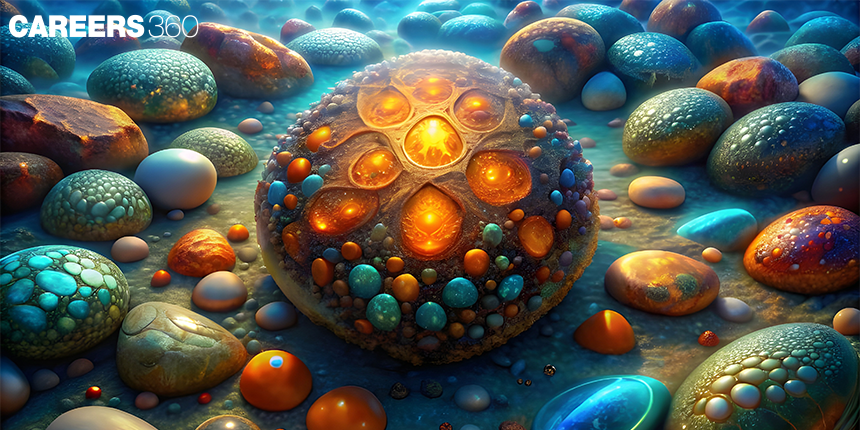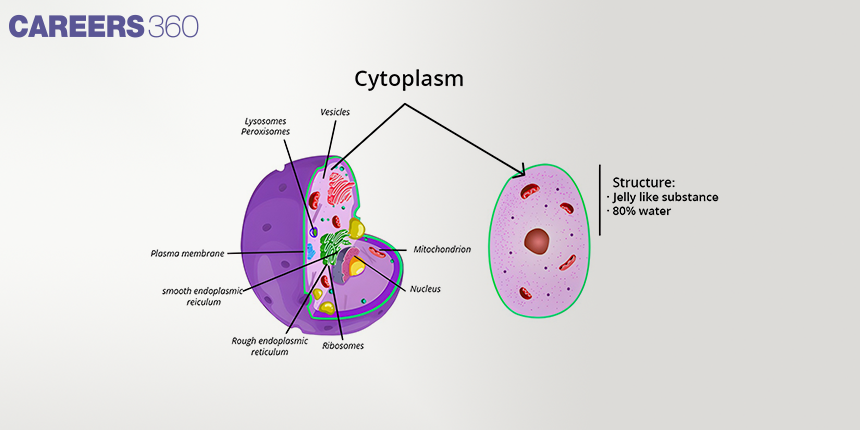Cytoplasm: Structure and Function
What is Cytoplasm?
The cytoplasm is that part of a cell that lies between the plasma membrane and the nuclear envelope—everything within the membrane but outside the nucleus. The cytoplasm comprises mainly cytosol and is the home of organelles. Organelles are specialised structures that have characteristic shapes and perform specific functions in the cell.
Don't Miss: Most scoring concepts for NEET | NEET papers with solutions
NEET 2025: Syllabus | PYQs | Crack NEET in 2 months - Study Plan
NEET Important PYQ & Solutions: Physics | Chemistry | Biology | NEET PYQ's (2015-24)
- What is Cytoplasm?
- Structure of the Cytoplasm
- Organelles Suspended in the Cytoplasm
- Cytoskeleton
- Functions of the Cytoplasm
- Dynamic Nature of the Cytoplasm
- Differences in Structure and Function:
- Applications and Importance

In cell biology, the cytoplasm is important for, but not limited to, maintaining the structural integrity of an individual cell, metabolic activities, and providing a space for intra-cellular transport. The cytoplasm provides a medium for the suspension of organelles and is involved in many of the activities of a cell, like growth, replication, and response to an external stimulus.
Structure of the Cytoplasm
Basic Composition
The cytoplasm is a highly complex and dynamic medium structure of the cell, composed of various elements that act in concert to permit cellular integrity and the ability of the cell to perform a wide range of functions.
Cytosol (Intracellular Fluid)
The cytosol is the semifluid portion of the cytoplasm. All the cellular processes take place in the cytosol. It is the matrix in which the various organelles are suspended.
It consists mainly of water (about 70-80%), but also of dissolved ions, small molecules, and large water-soluble molecules (such as proteins).
The cytosol is the site for a lot of metabolic pathways—for example, glycolysis—and has an important soft role in the transportation of metabolites and signalling molecules.
Organelles Suspended in the Cytoplasm
Mitochondria
There is a general understanding that the mitochondria are the powerhouses of the cell. It generates ATP through the process of oxidative phosphorylation.
Endoplasmic Reticulum (ER)
Rough ER is so named because it is studded with ribosomes that are actively involved in protein synthesis and protein modification.
The smooth ER does not have ribosomes and, hence, is not involved in protein synthesis. It involves lipid synthesis and detoxification processes.
Golgi Apparatus
Modifies, sorts, and packages proteins and lipids for secretion or delivery to other organelles.
Lysosomes
Contains hydrolytic enzymes for the digestion of macromolecules and worn-out organelles.
Peroxisomes
Involved in fatty acid metabolism and the detoxification of harmful substances.
Ribosomes
The sites of protein synthesis, either float freely in the cytoplasm or are attached to the rough ER.
Cytoskeleton
The cytoskeleton is a dynamic network of protein filaments within the cytoplasm, comprising microfilaments, intermediate filaments, and microtubules. Microfilaments, composed of actin, are involved in cell movement and shape maintenance. Intermediate filaments provide mechanical support and maintain cell integrity, while microtubules, made of tubulin, are essential for cell division, intracellular transport, and structural support. Together, these components help maintain cell shape, facilitate intracellular transport by acting as tracks for organelle movement, and play a crucial role in chromosome separation during mitosis and meiosis.
Diagram: Structure of a Cell Showing the Cytoplasm
Functions of the Cytoplasm
Support and Suspension of Organelles
The cytoplasm provides essential support and a kind of suspension for the cellular organelles.
It serves as a medium or a means for supplying organelles; it holds the organelles in the right position for their function and well-performing environment.
Such interaction between the cytoplasm and cytoskeletal components creates an appropriate cell shape and prevents deformation that can arise under certain mechanical stresses.
This interaction is extremely important for the spatial organisation of the cell and organelles within this cell.
Metabolic Activities
Metabolic events in the cytoplasm are very important for cell survival and performance.
The cytoplasm is a site for many biochemical events, also as glycolysis, leading to glucose processing and energy derivation.
It is also one of the significant places in the biosynthesis of proteins; ribosomes are located in the site and promote the translation of the information from mRNA into a peptide sequence.
Also, cellular respiration in animal cells usually takes place in the mitochondria; respiration starts in the cytoplasm, which therefore involves the cytoplasm in energy generation and the course of general metabolic reaction cycles.
Cellular Signalling
Cytoplasm is essential for cellular signalling and molecular transport.
It is used actively in intracellular transport, gaining movement of different molecular and cellular cargo necessary and sufficient for functional performance within a cell.
This intracellular movement is mainly by molecular diffusion, but in many cases, it is realised by the movements of vesicles or other cellular fragments, transferred within the cytoplasm.
Furthermore, cytoplasm has been known to be central to the signal transduction pathways that interface with the interactions at the plasma membrane by coupling these signalling events to the regulation of nuclear and organelle function.
This is also essential for proper cellular physiology, as well as well-regulated cell-to-cell communication.
Dynamic Nature of the Cytoplasm
Cytoplasmic Streaming
Cytoplasmic streaming, also known as cytoplasmic flow or protoplasmic streaming, is a process observed in many eukaryotic cells wherein the cytoplasm has constant, directed movement.
The movement is significant for different cellular processes, wherein it is particularly common in large plant or fungal cells because it helps in the distribution of nutrients, organelles, and other cell components.
This also enhances the efficient uptake of nutrients and excretion of waste within the cell, which also adds to the right concerns that the cell needs to sustain its metabolic processes.
All these complement its functions towards promoting cell growth, development, and response to different environmental events.
Changes During Cell Division
The dynamics of the cytoplasm are significantly different when the cell divides. This is more so within the cytokinesis, which marks the final step in cell division.
In both the processes of mitosis and meiosis, cytokinesis is the step that delineates cytoplasmic differentiation.
It is within this process that the cytoplasm is reorganised or redistributed. The reason for reorganisation is to ensure that each daughter cell has received the organelles and other cytoplasmic materials it needs in sufficient amounts to effectively survive and properly function.
This reorganisation is a very crucial process that helps the cell maintain its integrity and continues the genetic information from the parent cell.
The coordination between the dynamics of the cytoplasm and the cell cycle is very important for the distribution of cytoplasmic contents to be guaranteed and cell division to occur flawlessly, underscoring the dynamic nature of the cytoplasm in cellular approaches.
Differences in Structure and Function:
Cytoplasm
Semi-fluid material inside the cell and outside the nucleus.
Contains the organelles, cytoskeleton, and cytosol.
Location of metabolic activities, molecular transport, and cellular signalling.
Nucleus
Organelle bound by a membrane within the cell.
Contains DNA, chromatin, nucleolus, and a nuclear envelope.
Organelle that acts as a brain for the cell, as it controls the gene expression and DNA age.
Interaction between Cytoplasm and Nucleus:
Organelle that acts as a brain for the cell, as it controls the gene expression and DNA age.
The collaboration between the nucleus and the cytoplasm is extremely broad and sustains cellular activities.
Signals in the cytoplasm may influence gene expression and the response of the cell through the signal transduction pathway.
Many molecules—among them, both proteins and RNA molecules—pass back and forth between the cytoplasm and the nucleus for purposes of communication and transport of the genetic message.
Applications and Importance
Medical Applications
Understanding cytoplasmic dysfunctions will help identify the mechanisms of pathogenesis and disease and lead to effective treatments. Specific targeting of cytoplasmic molecules will enable the development of innovative therapies against numerous pathological conditions.
Biotechnological Applications
The significance of cytoplasm in genetic engineering and cell research finds a foundation. The ability to control processes in the cytoplasm leads to possible changes in gene expression and the engineering of cellular functions, which stimulate the progress of biotechnology by making the development of new therapies and diagnostic tools easy.
Frequently Asked Questions (FAQs)
Cytoplasm is the colloidal material of cells, excluding the cell nucleus, in which all cell organelles and other structures are suspended within the cytosol.
The cytoplasm serves as a medium for cellular activities, serving as a site for organelles, metabolic processes, and intracellular transport to take place.
It contains cytosol (intracellular fluid), organelles (such as mitochondria, and endoplasmic reticulum), and the cytoskeleton (microfilaments, microtubules).
Cytoplasm accommodates biochemical reactions in the form of glycolysis and protein synthesis and occupies a crucial role in energy production and molecular synthesis.
If there were no cytoplasm, cellular functions, such as metabolism, transport, and support, would not occur, and cells would be dead.
Also Read
27 Dec'24 05:51 PM
23 Nov'24 05:46 PM
08 Nov'24 05:04 PM
08 Nov'24 10:59 AM
08 Nov'24 09:54 AM
08 Nov'24 09:26 AM
08 Nov'24 09:01 AM
07 Nov'24 10:17 PM
07 Nov'24 09:50 PM
07 Nov'24 04:38 PM
